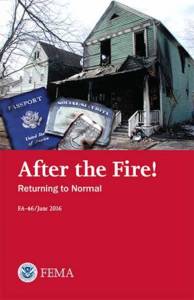
After a Fire
The U.S. Fire Administration has gathered the following information for you those who experience a home fire. “After the Fire: Returning to Normal” provides information on recovering from a fire, including what to do during the first 24 hours, insurance considerations, valuing property, replacing documents, salvage hints, fire department operations and more.

Carbon Monoxide Safety
What is carbon monoxide?
Carbon monoxide, also known as CO, is called the “Invisible Killer” because it’s a colorless, odorless, poisonous gas. More than 150 people in the Unites States die every year from accidental nonfire-related CO poisoning associated with consumer products, including generators. Other products include faulty, improperly-used or incorrectly-vented fuel-burning appliances such as furnaces, stoves, water heaters and fireplaces.
Know the symptoms of CO poisoning
Because CO is odorless, colorless, and otherwise undetectable to the human senses, people may not know that they are being exposed. The initial symptoms of low to moderate CO poisoning are similar to the flu (but without the fever). They include:
- Headache
- Fatigue
- Shortness of breath
- Nausea
- Dizziness
High level CO poisoning results in progressively more severe symptoms, including:
- Mental confusion
- Vomiting
- Loss of muscular coordination
- Loss of consciousness
- Ultimately death
Source: Consumer Product Safety Commission
Cooking Safety
Follow these tips for safe cooking:
- Keep an eye on what you fry.
- Stand by your pan.
- Turn pot handles toward the back of the stove.
- Wear short sleeves or roll sleeves up.
- Keep a pan lid or cookie sheet nearby to cover the pan if it catches on fire.
Source: U.S. Fire Administration
2010-2014 Cooking Stats:
- Unattended cooking is the leading factor in home cooking fires.
- Two-thirds of home cooking fires started when food or other cooking materials caught fire.
- Clothing was the item first ignited in less than one percent of these fires, but these incidents accounted for 18 percent of the cooking fire deaths.
- Ranges accounted for the largest share (62 percent) of home cooking fire incidents.
- More than half (55 percent) of reported non-fatal home cooking fire injuries occurred when the victims tried to fight the fire themselves.
- Frying poses the greatest risk of fire.
- Thanksgiving is the peak day for home cooking fires.
Source: National Fire Protection Association
Holiday Fire Safety
Facts about home holiday fires:
- One of every four home Christmas tree fires is caused by electrical problems.
- Although Christmas tree fires are not common, when they do occur, they are more likely to be serious. On average, one of every 32 reported home Christmas tree fires results in a death compared to an average of one death per 143 total reported home fires.
- A heat source too close to the tree causes one in every four Christmas tree fires.
- The top three days for home candle fires are Christmas, New Year’s Day, and Christmas Eve.
- Candles start two out of five home decoration structure fires.
Source: National Fire Protection Association
Home Heating Safety
Facts about home heating fires:
- From 2013-2015, an average of 45,900 home heating fires occurred in the United States each year. These fires caused an annual average of approximately 205 deaths, 725 injuries and $506 million in property loss.
- Heating was the second leading cause of home fires after cooking.
- Home heating fires peaked in the early evening hours between 5 and 9 p.m. with the highest peak between 6 and 8 p.m. This four-hour period accounted for 29 percent of all home heating fires.
- Home heating fires peaked in January (21 percent) and declined to the lowest point from June to August.
- Confined fires — fires confined to chimneys, flues or fuel burners — accounted for 75 percent of home heating fires.
- Twenty-nine percent of the nonconfined home heating fires — fires that spread past the object of origin — happened because the heat source (like a space heater or fire place) was too close to things that can burn.
Source: US Fire Administration
Smoke Detectors
We inspect and install smoke and carbon monoxide detectors in the City of Newaygo, Brooks Township, and part of Garfield Township. To Request detectors for your home, please complete the form below.
Detectors are provided for free through Michigan Safe.

